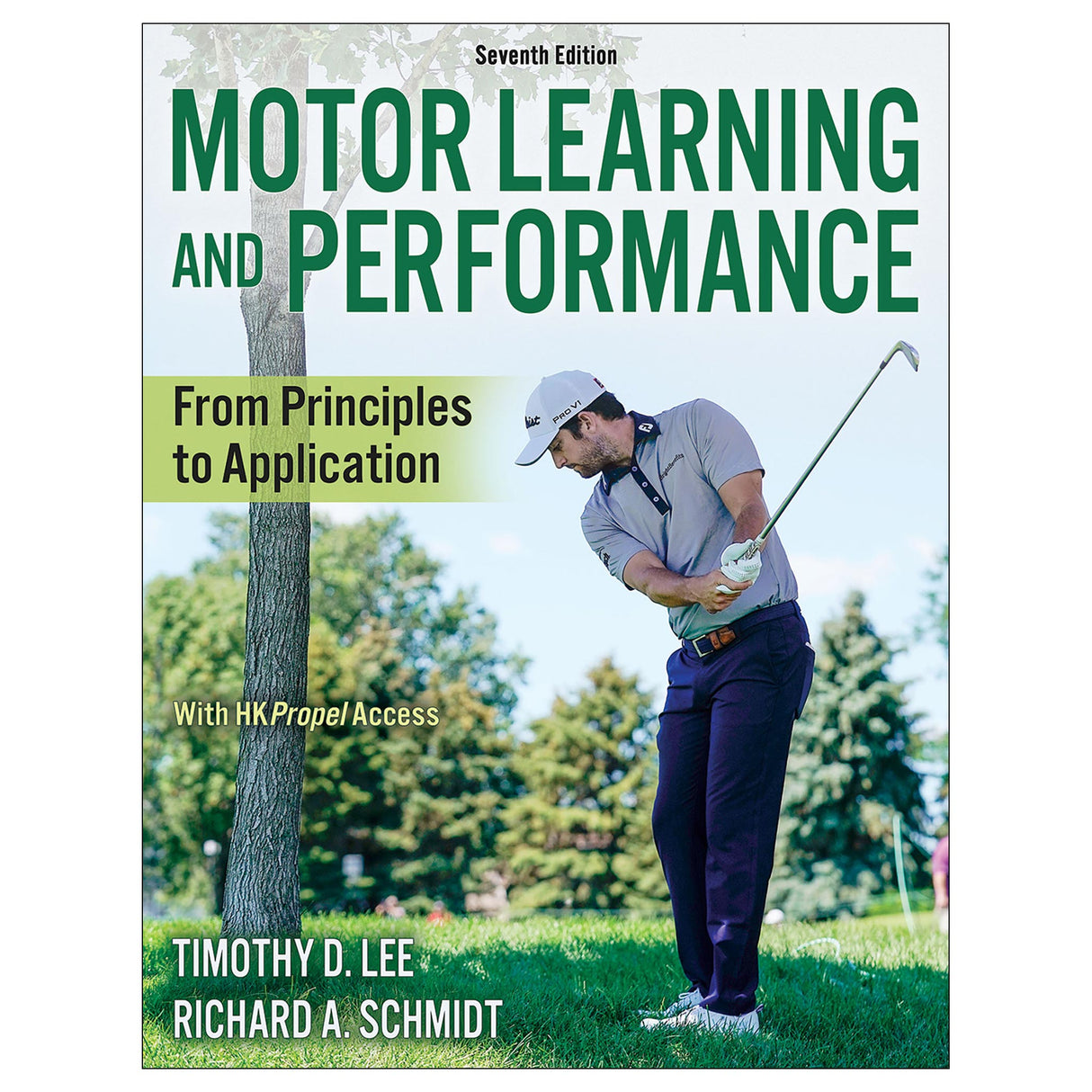Motor Learning and Performance 7th Edition Ebook With HKPropel Access
From Principles to Application
Author: Timothy D. Lee, Richard A. Schmidt
$156.95 CAD

The seventh edition of Motor Learning and Performance offers a new chapter that invites students to expand their thinking about the learning process by considering various theoretical explanations for how motor learning occurs. This latest edition has been carefully revised to incorporate the most recent and important research findings in the field, and it is supplemented with practice situations to facilitate a stronger link between research-based principles and practical applications.
Related multimedia components delivered through HKPropel further enrich the learning experience with 12 principles-to-application exercises, 53 interactive activities, and 27 lab activities that can be filled in online and printed or emailed. The 47 narratives from Motor Control in Everyday Actions that are referenced in the book have been updated and are provided in their entirety to illustrate how motor behavior is applicable to real life. Key term quizzes and flash cards offer students interactive opportunities to engage with the content—all of which can be assigned, and progress tracked, by instructors directly through HKPropel. In addition, chapter quizzes that test comprehension of critical concepts may be assigned and are automatically graded.
As the text investigates the principles of human performance, pedagogical aids such as learning objectives, key terms, and Check Your Understanding questions help students stay on track with learning in each chapter. Focus on Research and Focus on Application sidebars deliver more detailed research information and make connections to real-world applications in areas such as teaching, coaching, and therapy. Photo learning activities challenge students with visual exercises, and 48 figures with enlightening audio descriptions can be accessed via QR code.
The seventh edition of Motor Learning and Performance goes beyond simply presenting research—it challenges students to grasp the fundamental concepts of motor performance and learning and then go a step further by applying the concepts. Incorporating familiar scenarios brings real-world context to the material for students, leading to better retention and greater interest in practical application of motor performance and learning in their everyday lives and future.
Note: A code for accessing HKPropel is included with this ebook.
Audience
Introductory textbook for courses in motor learning, motor performance, and motor behavior; reference for movement practitioners, including coaches, teachers, therapists, athletic trainers, and human-factor experts.How Skills Are Studied
Why Study Motor Skills?
The Science of Motor Learning and Performance
Focus on Research 1.1 Paul M. Fitts
Focus on Research 1.2 Franklin M. Henry
Defining Skills
Components of Skills
Classifying Skills
Measuring Skilled Performance
Understanding Performance and Learning
Summary
HKPropel Activities
Part I. Principles of Skilled Performance
Chapter 2. Processing Information and Making Decisions
The Mental Side of Human Performance
The Information-Processing Approach
Focus on Application 2.1 Intent to Blow Whistle Rule in the NHL
Reaction Time and Decision-Making
Focus on Research 2.1 Hick’s Law
Focus on Application 2.2 Population Stereotypes
Focus on Research 2.2 Studying the Expert Advantage
Focus on Application 2.3 Cost–Benefit of Anticipating in Sprint Starting
Errors in Decision-Making
Memory
Summary
HKPropel Activities
Chapter 3. Attention and Performance
Information-Processing Limitations
Focus on Application 3.1 William James on Attention
What Is Attention?
Attentional Limitations in Stimulus Identification
Focus on Research 3.1 A Stroop-Like Effect in Basketball
Attentional Limitations in Response Selection
Focus on Research 3.2 Distracted-Driving Research
Attentional Limitations in Movement Programming
Focus on Research 3.3 The Double-Stimulation Paradigm
Attentional Focus During Action
Decision-Making Under Stress
Focus on Application 3.2 Driver Panic and Unintended Acceleration
Summary
HKPropel Activities
Chapter 4. Sensory Contributions to Skilled Performance
Feedback Processing in Motor Control
Sources of Sensory Information
Focus on Application 4.1 When Vision Distorts Performance
Processing Sensory Information
Focus on Application 4.2 Force Escalation Between Siblings
Vision and Motor Control
Focus on Research 4.1 Blindsight Reveals Dorsal and Ventral Stream Processing
Focus on Research 4.2 Gaze Control and the Quiet Eye
Audition and Motor Control
Summary
HKPropel Activities
Chapter 5. Motor Programs
Motor Control of Brief Actions
Motor Program Theory
Evidence for Motor Programs
Focus on Research 5.1 The Henry–Rogers Experiment
Focus on Application 5.1 Checked Swings in Baseball
Focus on Research 5.2 Initiating a Motor Program
Motor Programs and the Conceptual Model
Problems in Motor Program Theory: Novelty and Storage
Generalized Motor Program Theory
Focus on Research 5.3 Invariances and Parameters
Focus on Application 5.2 Relative-Timing Biometrics
Focus on Application 5.3 The Stereo System Analogy
Summary
HKPropel Activities
Chapter 6. Principles of Speed, Accuracy, and Timing
Controlling Simple Movements
Fitts’ Law
Focus on Research 6.1 Fitts’ Tasks
Focus on Application 6.1 Trading Off Speed and Accuracy
Focus on Application 6.2 Fitts’ Law in Daily Activities
Schmidt’s Law
Exceptions to Fitts’ and Schmidt’s Laws
Applying the Principles: Baseball Batting
Summary
HKPropel Activities
Chapter 7. Performance of Complex Movements
Differing Approaches to Understanding Coordination
The Differential Approach
Focus on Application 7.1 The Relative-Age Effect
The Ecological Approach
Focus on Research 7.1 Head–Arm Coordination in Golf Putting
Focus on Application 7.2 Usain Bolt Versus Tyson Gay
Focus on Research 7.2 Relative Phase: An Index of Coordination
Summary
HKPropel Activities
Part II. Principles of Skill Learning
Chapter 8. Introduction to Motor Learning
Concepts and Methods in Research and Application
Motor Learning Defined
How Is Motor Learning Measured?
Focus on Research 8.1 Learning Curves: Facts or Artifacts?
Distinguishing Learning From Performance
Focus on Application 8.1 Self-Assessments of Learning
Transfer of Learning
Summary
HKPropel Activities
Chapter 9. The Motor Learning Process
Practice, Retention, and Transfer
Two Principles of Practice
Focus on Research 9.1 The 10,000-Hour Rule Myth
Focus on Application 9.1 Learning Versus Performance During Practice
Benefits of Practice
Retention of Skill
Transfer of Skill
Focus on Application 9.2 From Esport to Real Sport
Summary
HKPropel Activities
Chapter 10. Organizing and Scheduling Practice
How the Structure of Practice Influences Learning
Distribution of Practice
Variability in Practice
Focus on Research 10.1 Especial Skills: An Exception to Variable Practice?
Focus on Research 10.2 Impact of Shea and Morgan
Motivation for Learning
Observational Learning and Mental Practice
Focus on Application 10.1 Mental Practice in Stroke Rehabilitation
Focus on Application 10.2 Practice Distribution Revisited
Summary
HKPropel Activities
Chapter 11. Augmented Feedback
How Supplemental Feedback Influences Learning
Feedback Classifications
Functions of Augmented Feedback
Focus on Research 11.1 Early Views on How Augmented Feedback Works
What Feedback to Give
How Much Feedback to Give
Feedback Timing
Focus on Application 11.1 Physical Guidance in Stroke Rehabilitation
Focus on Application 11.2 Physical Guidance in Learning to Swim
Summary
HKPropel Activities
Chapter 12. Theoretical Perspectives on Motor Learning
Understanding How Learning Occurs
Stage Theories
Adams’ Closed-Loop Theory
Schema Theory
Challenge Point Framework
Dynamic Pattern Theory
Constraints-Based Framework
OPTIMAL Theory
Summary
HKPropel Activities
All ancillaries are free to adopting instructors through HKPropel.
Instructor guide. Includes sample syllabi, chapter objectives, outlines, teaching ideas, supplemental readings, and solutions to the photo learning activities presented in the book. Also provided is an overview of the chapter activities, labs, and Motor Control in Everyday Actions narratives that are available to students.
Test package. Contains 389 questions in true-false, matching, fill-in-the-blank, essay and short-answer, and multiple-choice formats. The files may be downloaded for integration with a learning management system or printed for use as paper-based tests. Instructors may also create their own customized quizzes or tests from the test bank questions to assign to students directly through HKPropel. Multiple-choice and true-false questions are automatically graded, and instructors can review student scores in the platform.
Chapter quizzes. Contains ready-made quizzes (10 questions each) to assess student comprehension of the most important concepts in each chapter. Each quiz may be downloaded or assigned to students directly through HKPropel. The chapter quizzes are automatically graded, and instructors can review student scores in the platform.
Presentation package. Features more than 284 PowerPoint slides of text, artwork, and tables from the book that can be used for class discussion and presentation. The slides in the presentation package can be used directly within PowerPoint or printed to make handouts for students. Instructors can easily add, modify, and rearrange the order of the slides.
Image bank. Includes most of the figures and tables from the text, sorted by chapter. These can be used in developing a customized presentation based on specific course requirements.
Instructors also receive access to all student materials in HKPropel. For Motor Learning and Performance, Seventh Edition, this includes 12 principles-to-application exercises, 53 interactive activities, 27 lab activities, 47 narratives from Motor Control in Everyday Actions, key term quizzes, and flash cards—many of which can be assigned, and progress tracked, by instructors directly through HKPropel. In addition, chapter quizzes that test comprehension of critical concepts may be assigned and are automatically graded.









